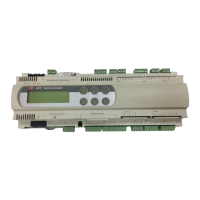Standard Chiller/HP modulare per compressore a vite con driver CAREL
Cod.: +030221241 Rel. 1.0 dated 25 September 03
29
11.5.2 Power-up of compressors (temperature above point E)
The compressors are powered up in sequence at a rate calculated by the set time required to reach maximum power.
As there is no absolute reference concerning the value of input power, as soon as it is started, the compressor performs a forced discharge cycle
for a set time (capacity control relays energised continuously according to the power discharge configuration).
Subsequently, the compressor power will be increased by maximum duration impulses.
11.5.3 Increase of compressor power
When the maximum time limit for reaching maximum power is reached, a forced charging cycle is commanded for a time of 20% of the set
threshold, then the compressor capacity control relays change to the power stand-by configuration.
If the temperature remains in the power-up zone (beyond point E), every ten minutes a forced charging cycle is commanded with a duration of
20% of the time required to reach the maximum set power.
In the case of multi-compressor units, the periodic forced charging cycle will be carried out by all powered up compressors which have reached
maximum power.
11.5.4 Modulated increase of power (temperature in range between points D-E)
The compressor's power is modulated in this temperature range, by applying charging impulses of variable duration to the capacity control
relays (duration is calculated between the minimum and maximum values set according to the measured temperature values).
For multi-compressor units, modulated increase of power will occur simultaneously for all powered up compressors.
11.5.5 Operation of compressor in neutral zone (temperature in range between points C-D)
If the temperature value locates inside the neutral zone, the capacity control relays of all powered up compressors change to the power stand-by
configuration, thus maintaining the power level that had been reached.
11.5.6 Modulated reduction of power (temperature in range between points C-B)
The compressor's power is modulated in this temperature range, by applying discharging impulses of variable duration to the capacity control
relays (duration is calculated between the minimum and maximum values set according to the measured temperature values).
For multi-compressor units, modulated reduction of power will occur simultaneously for all powered up compressors.
11.5.7 Power-down of compressors (temperature below point B)
The compressors are first of all discharged by applying maximum duration discharging impulses to the capacity control relays.
The compressors are then powered down, by reducing the number of requested devices, at a rate equal to the time required to reach minimum
set power.
FIFO Rotation is applied, whereby the first powered up compressor is discharged and then powered down. Instead, if rotation is disabled, the
last powered-up compressors is discharged and then powered down.
12 Compressor rotation
Compressor calls are rotated in order to equal the number of duty hours and power-ups among the devices. Rotation follows the FIFO logic: the
first compressor to be powered up is the first to be powered down. At the initial stage, there may be considerable differences in the on-duty
hours of the compressors, however, the hours are very similar to each other in steady state.
Rotation occurs only among compressors and not among capacity controls, and, in any case, this type of rotation operates only if the
compressors have stepped capacity control.
Rotation-free management
• Power-up: C1,C2,C3,C4.
• Power-down: C4,C3,C2,C1.
FIFO rotation management (the first compressor to be powered up is the first to be powered down):
• Power-up: C1,C2,C3,C4.
• Power-down: C1,C2,C3,C4.

